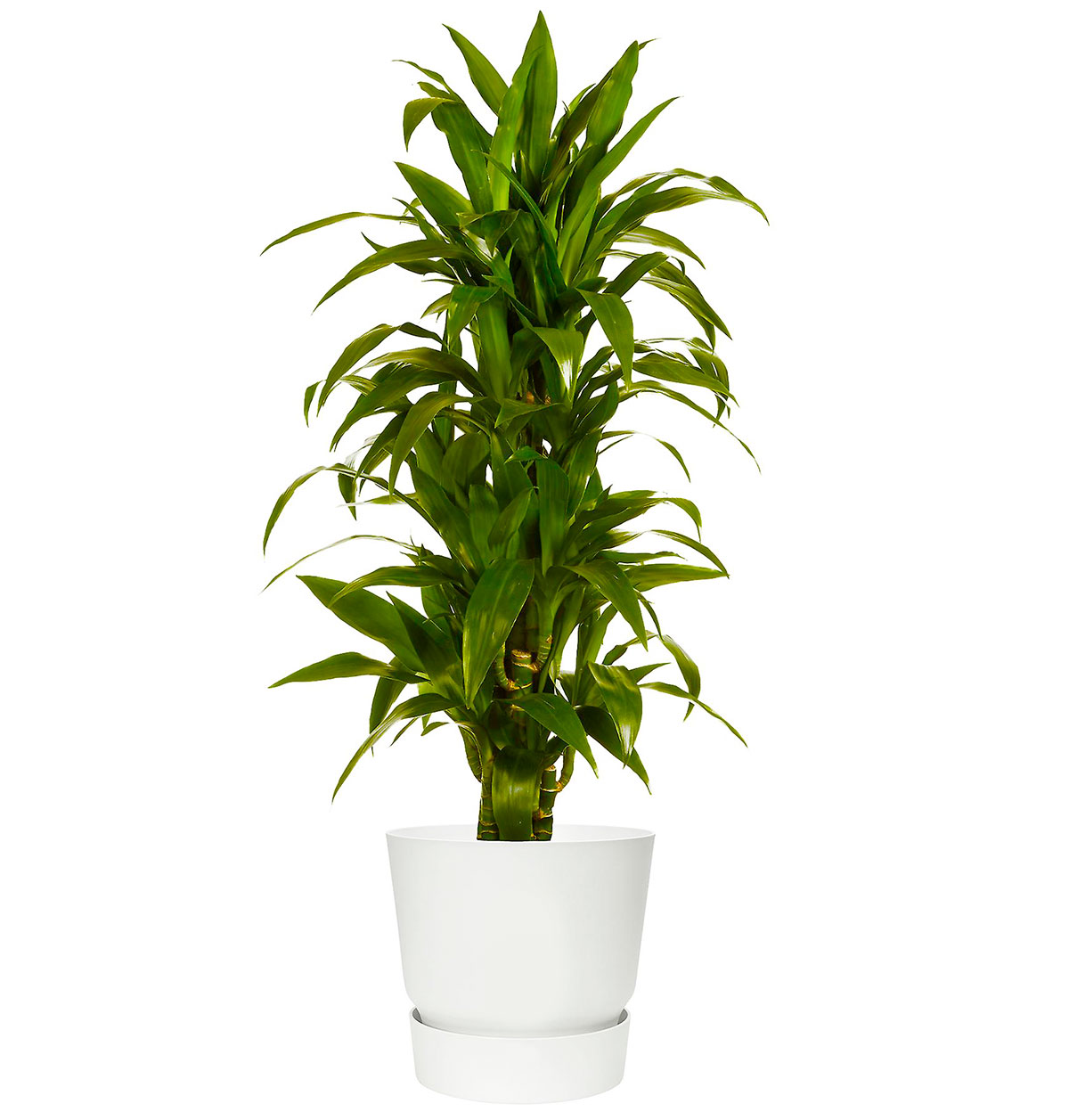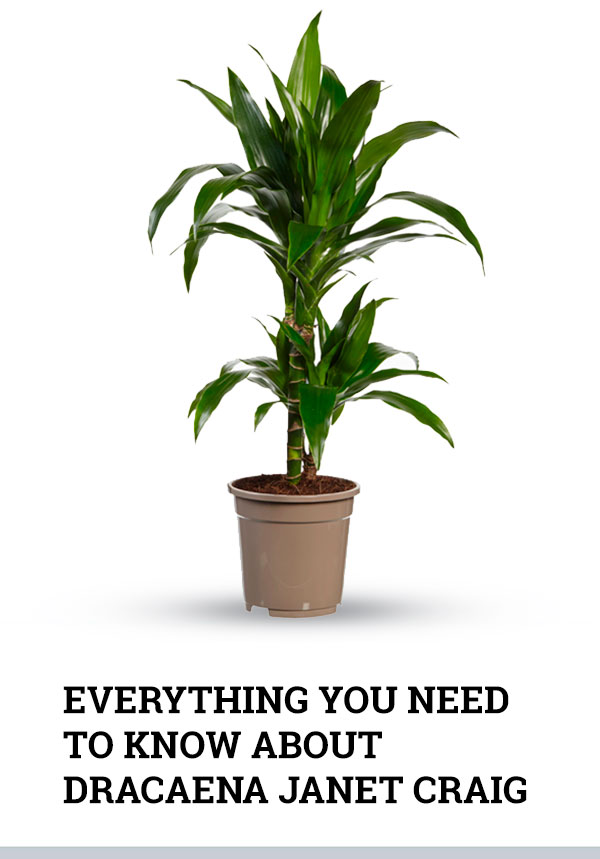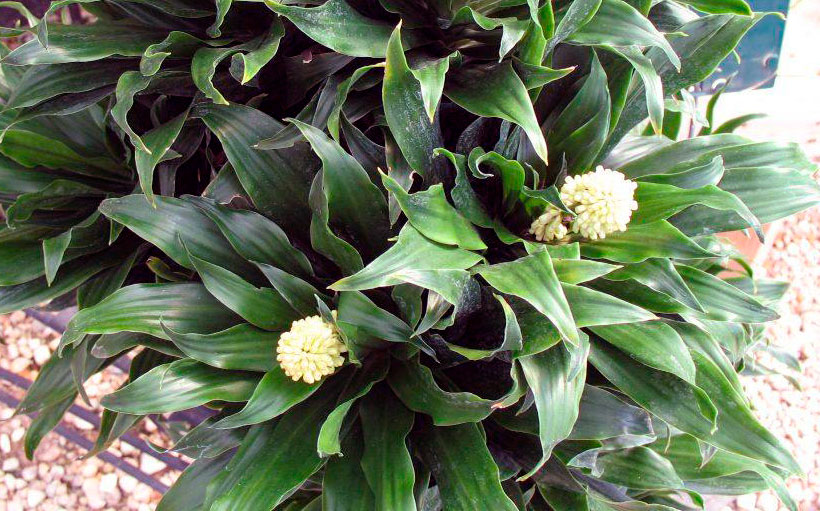When you know what to plant next to this or...
Dracaena Janet Craig Plant Care Guide
There are more than 100 dracaena species. Dracaena Deremensis and Dracaena Fragrans (Corn Plant) are most often used for landscaping interiors. Dracaena Janet Craig, belonging to the Dracaena Fragrans species, has a spectacular appearance and is easy to care for. An exotic plant with bright juicy greenery can be a decoration for both home and industrial or office interiors. Dense foliage cleans the air well from harmful impurities and regulates water-gas exchange in the room. Feng Shui experts believe that dracaena brings harmony, love and well-being to the house.
✔ We Released The Dracaena HandBook
CLICK HERE TO LEARN MORE >>
Dracaena Janet Craig Plant
Dracaena Janet Craig belongs to the genus of evergreens from the asparagus family, which grows wild in the African and South Asian tropics.
In tropical thickets, there are specimens up to 6 m high. Indoor decorative deciduous dracaena varieties often grow up to 1.5-2 m, in rare cases - up to 3-4 m. An upright lignified trunk has many transverse stripes: these are traces of dead leaves.
Dracaena Janet Craig is a fragrant species, but it rarely blooms at home. The forming dense inflorescences in the form of a brush are pinkish on the outside. White or creamy flowers have a pleasant herbaceous honey aroma.
A young plant is formed in the form of a shrub with lanceolate leaves 3-4 cm wide and 25-30 cm long. Adult "palms" have leaves more than half a meter in length, curving downward.
There are dormant buds on the stem, from which leaf rosettes are expelled. A properly formed plant takes on a given lush shape. In flower shops such a dracaena can be found marked "Janet Craig Branch".
The flower growers have developed a miniature form - Dracaena Janet Craig Compacta. It is distinguished by slow growth rates: the shrub grows by only 3-4 cm during the year. An adult plant reaches 35-40 cm in height. The leaves up to 15 cm long are collected in a dense bundle.

Dracaena Janet Craig: Plant Care Guide
The exotic culture has adapted well to indoor conditions in different climatic zones, including those with a temperate and harsh continental climate.
To keep the plant strong and healthy, follow these simple rules:
Do not overmoisten the soil
Do not place the flower in direct sunlight
Avoid drafts and sudden temperature changes

Lighting
The best place for Dracaena Janet Craig is on the west or southwest side of the room. Plant pots are best placed closer to the window, but not on the windowsill. If the "palm" stands in a corner or other shaded place, it needs additional lighting. With insufficient light, the leaves become lethargic and pale, the stem starts to stretch and new rosettes do not develop.
In winter, it’s better to place Dracaena Janet Craig away from the heating devices.
Watering
Moderate soil moisture and loose soil structure ensure healthy growth of the aboveground part and root system of Dracaena Janet Craig.
During spring and summer, Dracaena Janet Craig needs to be watered 2 times a week. First, you should check the moisture of the soil at a depth of 2 cm: if the soil is dry, water it until moisture appears in the pallet. It is better to drain the excess water so that the roots do not rot.
It is recommended to pass the water for irrigation through a charcoal filter. You can add charcoal to a container of water while settling it.
Spray Dracaena Janet Craig from a spray bottle or give it a shower. At the same time, water should not be allowed to stagnate in the bases of the leaves - it leads to decay of the trunk.
If the air in the room is dry, you can put a decorative container with water next to the plant.
In winter, watering is reduced to 2-3 times a month (depending on air humidity).
Temperature
In summer, dracaena grows well on balconies and in shady corners of the garden. The most favorable air temperature is + 22 °C ... + 26 °C.
In winter, it is desirable to lower the temperature to +16 °C + 18 °C.

Fertilizer
Any universal fertilizer is suitable for feeding Dracaena Janet Craig, but it is better to use specialized feeding intended for palm trees or non-flowering indoor plants.
From the beginning of March to the end of October, the plant should be fertilized 2 times a month. For the rest of the time, dracaena should be fed once a month, using a half dose.
Fertilizers are applied to Dracaena Janet Craig after watering, strictly adhering to the manufacturer's recommendations.
Repotting
In the first 3-4 years, the plant should be repotted annually (preferably in early spring). After the end of active growth, the top layer of the soil can be renewed, and repotting can be done in 2-3 years, when the roots become cramped in the old pot.
The diameter of the new pot should be 5-6 cm larger than the previous one. It is better to use commercially available soil mixes for Dracaena Janet Craig as a soil, or compose it from compost (2 parts), sheet soil (3 parts), peat (1 part) and sand (1 part).
Sometimes flower growers add vermiculite or charcoal to the soil mix. Such a soil composition has good air permeability, but at the same time it firmly holds the palm tree in an upright position, which is very important. The bottom of the pot for Dracaena Janet Craig must be filled with a layer of drainage from expanded clay, pebbles, clay shards.
When repotting, you can renew the root system by cutting out the old darkened roots and leaving light yellow roots.
Pruning and shaping the crown of Dracaena Janet Craig
If the plant is very elongated and you are not satisfied with the number of shoots and green mass, then you can cut the crown. To do this to your Dracaena Janet Craig cut off the top of the plant. This must be done with a sharp knife and a clear cut. To make the cut site quickly overgrown, treat it with a special antiseptic. After a while, several new shoots will appear on the trunk, which will form a more lush crown.
Poisonous
Remember that Dracaena Janet Craig is toxic to both cats and dogs. Do not allow your pets chew the leaves of the plant. It can cause weakness, vomiting and indigestion. At the first signs of poisoning, immediately bring your pet to a veterinarian. See more about pets and the effect toxins have here at the ASPCA.
How to propagate Dracaena Janet Craig

There are 2 types of Dracaena Janet Craig propagation: by seeds and by cuttings.
You can find Dracaena Janet Craig seeds on sale, but it is difficult to say what decorative qualities the plant that grows from them will have. Therefore, it is easier to propagate the plant by cuttings.
Vegetative propagation is carried out by lignified cuttings without leaves or parts of the stem with a leaf rosette. The first method is used if you need to get many plants at the same time. In the second method, the number of plants obtained corresponds to the number of shoots cut from the mother shrub.
By lignified cuttings
If you want to get several plants, cut the stem with a diameter of 12-13 mm into cuttings about 15 cm long. Make the cut with a sharp knife or pruning shears along the line of the leaf scar.
Put the cuttings for several hours in a solution that stimulates root formation.
Then place a third of their length in peat pots or plastic glasses with loose soil (sand, peat, leafy soil in equal parts).
Cuttings can be placed horizontally, sprinkling the middle with soil. In this case, both ends give young shoots.
To make rooting faster, cover the pots with foil or glass.
By parts of the stem with a leaf-rosette
Rooting material is harvested from the plants you like. Choose small but well-developed dracaenas. Make a cut with pruning shears 1-1.5 cm below the first leaf. You can cut lower, but the roots will take longer to form. A new rosette of leaves will gradually grow on the remainder of the shoot. Place the cut shoot in water for 7-14 days to allow the roots to grow back. Then repot into a permanent pot.
Problems when growing and diseases of Dracaena Janet Craig

Dracaena Janet Craig is an unpretentious plant, but violations of the rules of care are quickly reflected in its appearance.
With insufficient watering, the leaves lose their shine and elasticity, the top of the plant dries up.
Excessive humidity and soil moisture leads to decay of roots and bacterial / fungal diseases, such as bacteriosis, alternaria and phyllosticosis. If measures to combat these diseases are not taken in time, the plant may die.
Insufficient humidity can lead to drying out of the tips of the leaves.
A weakened plant is faster attacked by fungal and bacterial diseases.
If the plant has undergone rotten diseases, it is necessary to get rid of the damaged leaves and change the soil in the pot.
Treatment with fungicides will help get rid of bacterial and fungal diseases. Pest infestation often occurs outdoors, but sometimes parasites enter the house with new flowers that have not passed quarantine.
Scale insects can be determined by a sticky coating on the surface of the leaf, on the back side - by the accumulation of black dots-larvae.
The spider mite settles along the veins on the underside of the leaves. Light spots appear in the places where the mite draws out nutritious juices.
It is easier to fight pests and diseases at an early stage, so it is necessary to regularly inspect the plant, and use insecticidal or bactericidal preparations if you notice problems.

Dracaena Janet Craig: Reviews
According to gardeners, Dracaena Janet Craig is the most attractive and unpretentious Dracaena variety. The plant can withstand the growing conditions at the back of the room. At the same time, the leaves will not become pale. If the flower stands in one place for a long time, the rosette of leaves turns towards the light source and the stem may be bent. To avoid this, rotate the flower every 2-3 weeks.
Dracaena Janet Craig is perfect for busy people who often forget to water the plants in time. Dracaena Janet Craig easily tolerates the dry period, the leaves slightly droop down, but this does not affect the growth of the plant as a whole. The main thing is that after the absence of watering, give watering to a plant in small portions.
To the commonest of dracaena types belong:
- Snake Plant
- Marginata
- Sanderiana
- Reflexa
- Fragrans
- Lemon Lime
- Warneckii
- Massangeana
- Compacta
- Deremensis
- Draco (Dragon Tree)
- Lisa Cane
About the Author
My name is Michael Bauer, I have been growing and taking care of plants for 20 years. My dream has become a reality. I've had many difficulties along the way, but my love for our favorite plants has really helped me.So join us!
















